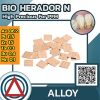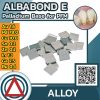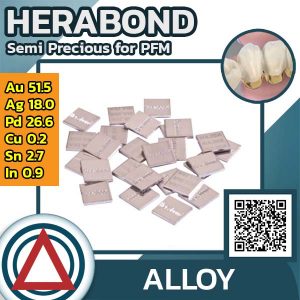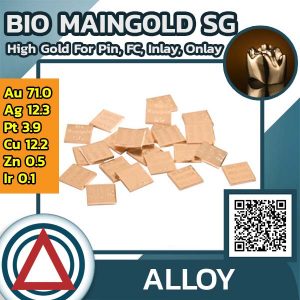AlbaSun (ราคาปรับตามราคาตลาดโลก)
Universal Casting and Bonding Alloy (สีขาว)
(gold dental casting alloy acc. to EN ISO 22674 and 9693-1)
ข้อได้เปรียบ
– เป็น Alloy ที่มีส่วนผสมของ Silver และ Gold
– ไม่มี Copper เป็นส่วนประกอบ
– ส่วนประกอบของ Oxide น้อย
– Warp Resistance สูง
– Wide indication range
– เป็นทางเลือกที่ดีที่มาแทน Non Precious Metal
ประเภทงานที่เหมาะ
– Inlays
– MOD inlays
– Crowns
– Bridges
– Cast post
– Pin
***ไม่สามารถทำ PFM ได้***
แอดไลน์เพื่อสอบถามราคาและโปรโมชั่น
Add to Wishlist
Add to Wishlist
Description

| Universal fire-bondable alloy acc. to EN ISO 22674 and EN ISO 9693 | |
| Type | 4 (v), 3 (s/ k) |
| Shade | White |
| Indication | 1,2,3,4,5,10,14 |
| Composition | Au 2.0 Ag 58.0 Pd 32.9 Sn 2.0 Zn 3.5 In 1.5 Ir x Ru x |
| Technical specifications, melting and casting | |
| Melting range | 1045 ° – 1105 ° C |
| Preheating temperature | 800 ° C |
| Casting temperature | 1235 ° C |
| Crucible | Graphite |
| Density | 10.8 g/cm3 |
| Hardness (HV5) | 150/175 (w/k), 210 (v), 170 (s) |
| 0.2 % yield strength (MPa) | 310 (w/k), 450 (v) |
| Elongation (%) | 11 (w/k), 5 (v) |
| Young’s modulus of elasticity (GPa) | 108 |
| Ceramic firing | |
| CTE | 16.6 |
| Oxide firing | 800 ° C/ 10 min. (stripping) |
| Soft annealing | 800 ° C/ 15 min. |
| Hardening | 550 ° C/ 15 min. |
| Solder/laser welding wire | |
| Solder | HeraSun solder 1, 900 HeraSun solder 2, 710 |
| Laser welding wires | 0.5 mm + 0.3 mm |
x = content < 0.1 mass%
Indications:
1 Inlays, cervical filling
2 MOD Inlays
3 Crowns
4 Bridges
5 Milling technique
6 Partial dentures
10 Cast posts
14 Can be veneered with high expansion, low-fusing ceramics
15 Implant restorations
16 Electroformed double crown technique (primary crowns)
1 Inlays, cervical filling
2 MOD Inlays
3 Crowns
4 Bridges
5 Milling technique
6 Partial dentures
10 Cast posts
14 Can be veneered with high expansion, low-fusing ceramics
15 Implant restorations
16 Electroformed double crown technique (primary crowns)
Footnotes:
w = after soft annealing and quenching
k = ceramic bonding alloy: condition after ceramic firing
v = after hardening
s = self-hardening after slow cooling in the mould
w = after soft annealing and quenching
k = ceramic bonding alloy: condition after ceramic firing
v = after hardening
s = self-hardening after slow cooling in the mould
A = A stable framework design with reinforced connections with a cross section of 8 – 10 mm² is required for long span bridges and superstructures. Additionally, the frameworks need to be hardened.
B = Depending on the copper content, in some cases discolouration ofdouble crowns may result after short period of wearing. Discolouration, however, is technically and physiologically harmless.
C = In exceptional cases these alloys can also be used for traditional telescopic crowns with parallel walls and for the bar casting technique provided that cross-sections for crown walls, approximal areas, bars and laser welded joints are particularly thick and the alloy is hardened subsequently. No indication for conical crowns and sheardistributors.
B = Depending on the copper content, in some cases discolouration ofdouble crowns may result after short period of wearing. Discolouration, however, is technically and physiologically harmless.
C = In exceptional cases these alloys can also be used for traditional telescopic crowns with parallel walls and for the bar casting technique provided that cross-sections for crown walls, approximal areas, bars and laser welded joints are particularly thick and the alloy is hardened subsequently. No indication for conical crowns and sheardistributors.







